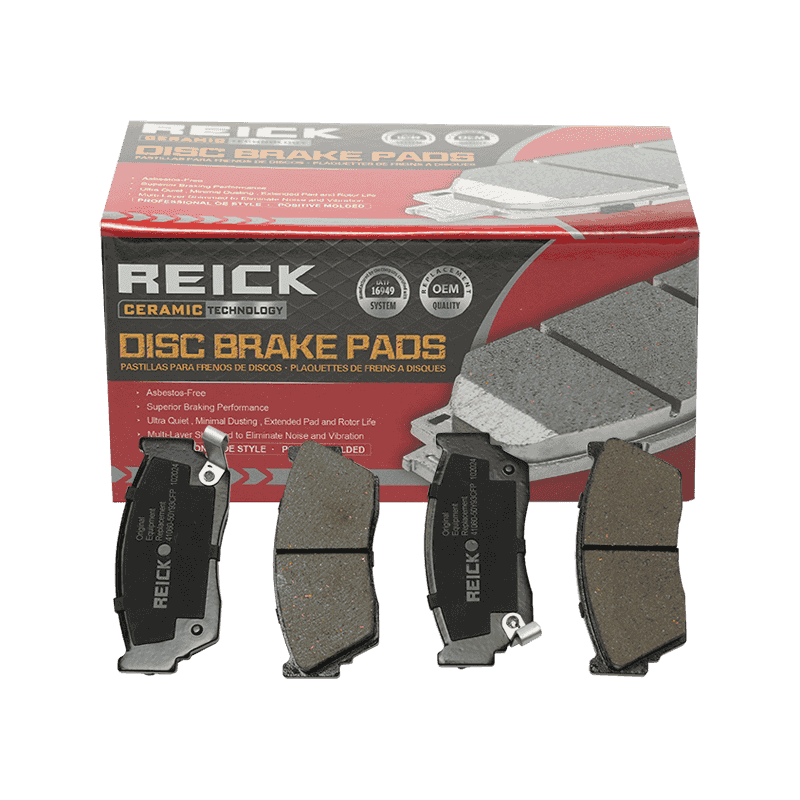 2025.02.12
2025.02.12
 Industry News
Industry News
Uneven wear on automotive brake pads is a frequent issue that can compromise vehicle safety, reduce performance, and increase maintenance costs. Brake pads are crucial for stopping your vehicle, and their condition directly impacts both your safety and the longevity of your braking system. Identifying the causes of uneven wear is essential to maintaining your vehicle in optimal condition. In this article, we’ll explore the most common reasons for uneven brake pad wear and discuss how they can be prevented.
Improper Brake Pad Installation
One of the primary causes of uneven brake pad wear is improper installation. When brake pads are not aligned or installed correctly, they can make uneven contact with the rotor. This misalignment causes certain areas of the pad to wear more quickly than others, leading to premature damage. Ensuring that pads are installed by a qualified technician, using precise tools and techniques, can prevent this issue from arising.
Faulty Brake Calipers
Brake calipers are responsible for pressing the brake pads against the rotor to create the necessary friction to slow down your vehicle. If a caliper becomes stuck or fails to release properly, it can cause the brake pad to remain in constant contact with the rotor. This persistent friction leads to accelerated wear on one side of the brake pad. Sticking calipers may also cause the vehicle to pull to one side during braking. Regular inspection of the calipers can prevent this issue, ensuring they operate smoothly and evenly.
Worn or Uneven Brake Rotors
Brake rotors, the flat discs that the brake pads press against, play a significant role in ensuring even pad wear. If the rotors become warped or uneven, they can create an irregular surface for the brake pads to contact. This can lead to uneven braking forces being applied, which, in turn, results in uneven pad wear. To avoid this, it is essential to regularly inspect and resurface the rotors if necessary. Replacing rotors that are too worn or damaged is also a critical step in maintaining the overall health of the braking system.
Misaligned or Damaged Suspension Components
A misaligned or damaged suspension system can directly impact how your brake pads wear. If the suspension components—such as shocks, struts, or control arms—are not functioning correctly, they can cause uneven weight distribution on the vehicle. This imbalance places extra pressure on one or more wheels, leading to irregular brake pad wear. Ensuring that the suspension is regularly maintained and aligned can prevent undue strain on the braking system and promote more even pad wear.
Driving Habits
Your driving style plays a significant role in the lifespan of your brake pads. Aggressive driving, such as rapid acceleration, hard braking, or frequent high-speed stops, can cause uneven wear. When brake pads are subjected to extreme forces, one part of the pad may wear down faster than the rest, leading to uneven braking performance. On the other hand, gentle and smooth driving can help distribute braking forces more evenly across the pad, promoting longer and more uniform wear.

Brake Pad Material Quality
Not all brake pads are created equal. The material composition of the pads can significantly influence how they wear over time. Low-quality materials or cheaper pads may wear down more quickly, leading to uneven wear patterns. On the other hand, higher-quality pads made from premium materials tend to wear more evenly and provide better performance, reducing the chances of problems. Investing in high-quality brake pads is a proactive measure that can prevent many of the issues that lead to uneven wear.
Brake Fluid Leaks or Contamination
Brake fluid plays a crucial role in the proper functioning of the braking system, but if the fluid becomes contaminated or leaks, it can cause uneven brake pad wear. Leaks in the brake lines or contamination from water, dirt, or air can affect the hydraulic pressure applied by the brake system, resulting in inconsistent pad wear. Regular checks for fluid leaks, as well as using the correct brake fluid, can help avoid this issue.
Excessive Heat Build-Up
When the brake system generates too much heat, it can cause the brake pads to wear unevenly. Excessive heat can result from frequent or prolonged braking, such as during long downhill descents, or from driving with an improperly maintained brake system. Heat can soften the brake pad material, causing it to wear more quickly in certain areas. Installing ventilated rotors or high-performance brake pads designed for heat dissipation can help mitigate the effects of excessive heat build-up.
Uneven brake pad wear is a problem that can often be traced to one or more underlying causes. By identifying and addressing these causes early, you can ensure that your vehicle’s braking system operates at peak efficiency, ultimately saving you money on repairs and enhancing your safety on the road. Regular maintenance, from checking the condition of your brake pads and calipers to ensuring proper suspension alignment, can significantly extend the life of your brake system. Whether through proper installation, attention to driving habits, or using high-quality parts, preventing uneven brake pad wear is essential to the overall health of your vehicle.
Recommended Products
+86-139 6193 3287
+86-515-88410559
+86-515-88580498
reickchina@reickparts.com
B1002 Huabang Dong No.1# South Renmin Road, Tinghu District, Yancheng City, Jiangsu, China
Copyright © 2024 Yancheng Reick Automotive Parts Co., Ltd. All Rights Reserved.
Automotive Brake Manufacturers Automotive Clutch Parts Suppliers


 English
English Español
Español italiano
italiano